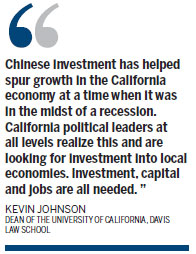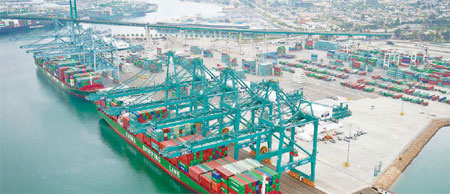California dealing
Updated: 2012-11-16 15:07
By Chen Jia and Joseph Boris (China Daily)
|
||||||||
|
Vessels operated by the North American subsidiary of China Shipping Container Lines Co are docked at the Port of Los Angeles, one of the main US transit points for goods bound for and coming from Asia. California hopes to build on its established commercial and cultural links to China to increase the volume and value of Chinese investments in the state. Provided to China Daily |
|
The Tribune Tower is reflected in a building across the street in downtown Oakland. A group of investors, mostly from China, bought the landmark structure for $8 million last year. Chen Gang / for China Daily |

The Golden State, now No 5 in the US in the value of investment from China, aims to climb higher by tapping its intrinsic strengths, China Daily's Chen Jia and Joseph Boris report.
With China a top target for US municipalities and states seeking foreign investment, one destination can put a number on its potential appeal to Chinese capital: $60 billion.
By 2020, California could attract that amount from China, according to an October report by the Rhodium Group, a consulting firm in New York that tracks Chinese outward investment. The report, co-published by the Asia Society, was issued in Chinese at events this week in Shanghai and Beijing.
California accounts for more than a quarter of all Chinese investments in the United States, having notched 156 deals between 2000 and 2011. That was more than the top four recipients - New York, Texas, Illinois and North Carolina - combined.
But in terms of total investment value, California ranks fifth in the nation, with $1.3 billion from deals consummated in the past 12 years, according to the report.
Through 2008, Chinese direct investment in the US was typically below $1 billion a year. Since soaring to just under $2 billion in 2009, activity has been growing at an unprecedented clip. From January through September of this year, Rhodium said in a separate report, the figure hit $6.3 billion - eclipsing even the full-year record of 2010.
The Golden State in particular is poised to benefit from this upward trend. But it will have to grab a bigger chunk of Chinese investment on these shores to reach the Rhodium report's $60 billion target in eight years. That will happen only "if the state and private sector do a better job working together to attract Chinese capital," the report advises.
"California is a good target for Chinese investors because we are looking for infrastructural development such as hotels and a baseball stadium," Jean Quan, the mayor of Oakland in northern California, told China Daily.
Quan expects increased investment from China in coming years, particularly in property development, which is so important to her city. This will be due in large part, she says, to Congress' recent extension through September 2015 of the EB-5 visa program.
Under EB-5, an applicant is given permanent US residency if his investment of at least $1 million leads to 10 full-time jobs within two years. The threshold is just $500,000 if the jobs created are in a rural or highunemployment
area of the US.
"This can guarantee a steady rate of return for stimulating purchases of bonds (for publicly funded development projects), and people are able to immigrate because of EB-5, so you'll see more of this in California," Quan said.
Local officials in the US including Quan have said real estate investors from China's growing middle- and upper-income populations seem particularly interested in the visa program.
The 2008-09 financial crisis, spurred by the collapse of the US housing-market bubble, left banks and other lenders reluctant to finance residential or commercial developments, stalling projects including several in hard-hit California. For municipal and state governments that slashed spending to deal with reduced tax revenue as property prices sank, foreign investors are increasingly sought as a financing source.
Oakland is an easy fit for Chinese investors, with hotels close to the city's predominantly Chinese-American neighborhoods and a large population of skilled, bilingual workers.
"There is a growing middle class and more tourism in China," Quan said. "Chinese understand exporting and importing, and there is more interest in import-export exchanges."
As an example, the mayor cited the deal for the Tribune Tower, a city landmark whose neon sign bears the name of Oakland's daily newspaper, a former tenant.
In late 2011 the 20-story, 88,000-squarefoot (8,175-square-meter) building was bought in foreclosure for $8 million by a group of private investors assembled by businessman and Oakland native Tom Henderson. Henderson won't identify the investors by name, but he has said most are from China.
The Tribune Tower now houses CallSocket LLC, a call-center operator that Henderson co-founded, as well as another of his startups, San Francisco Regional Center LLC, which attempts to find prospective EB-5 immigrants who could help finance local development projects. The company - and Henderson - would take a stake in any deal and operate as a general partner on the project that's formed.
In addition, Henderson is investing $3 million to $4 million to renovate the building, helping to attract tenants, including a ground-floor restaurant, for the rest of the building.
The businessman told China Daily that CallSocket, which so far has created 300 jobs in the city, could be a job-creation model through the immigrant-investor program.
"We are bringing in $100 million to Oakland alone. Over the next 18 months, we'll create 2,000 jobs in Oakland through the EB-5 program," said Henderson, who recently returned to California from China. The trip was his 19th to China since January 2011; Henderson has offices in Shanghai, Beijing and Guangzhou, he said.
Henderson's San Francisco Regional Center was established under the auspices of US Citizenship and Immigration Services, the government agency that created the EB-5 program in 1990.
Such entities - private companies, public bodies or a partnership between the two - are obliged to try to attract foreign investors with the goal of creating jobs in economically blighted areas of US cities. The federal immigration agency uses economic and employment data to monitor the Regional Centers' progress.
About 95 percent of prospective EB-5 immigrants turn to Regional Centers to help navigate the visa-application process, a USCIS spokesman was quoted as telling the Wall Street Journal earlier this year.
There are 245 Regional Centers in the US, 61 of them in California, according to the USCIS website.
Mayor Quan said she's seeking EB-5 money from Chinese investors for either of two potential projects, Victory Court and Coliseum City, that would be home to Oakland's professional baseball, basketball and football teams.
Quan, Oakland's first woman mayor and the first Chinese-American to lead a major US city, headed a trade mission to China last year to spur investment in her largely working-class city across the bay from San Francisco.
She's not the only elected official in California to recognize the importance of establishing closer relationships with China.Quan and her in-state counterparts would like to unite potential partners.
In June, eight mayors and legislators from Los Angeles County visited China at the invitation of the Chinese People's Association for Friendship with Foreign Countries and the China Association of Mayors. The Californians spent 10 days meeting with local-government and senior officials in Beijing, Shanghai and Nanjing.
Ed Lee, the Chinese-American mayor of San Francisco, is preparing to visit China next year, according to Darlene Chiu Bryant, executive director of ChinaSF, an economic development initiative of the city.
As more Chinese companies set up offices and expand operations in North America, San Francisco aims to guide those considering a move through each stage of decision-making and relocation. ChinaSF has a bilingual staff and offices in San Francisco, Shanghai and Beijing that support an exchange of ideas.
"Entrepreneurs and small and mediumsize enterprises value California for its advanced legal structures, openness to new products and partners, worldliness toward non-Americans and strong business facilitation services, among other advantages," according to the Rhodium Group report. It highlights efforts of public-private partnerships such as ChinaSF as well as business groups like the Bay Area Council and the California governor's GO-Biz agency, which aims to simplify firms' entry into the state.
Chinese investment in the United States has taken various forms. One local politician even made it a key plank of his election platform.
Stewart Chen, a chiropractor who ran for one of two open seats on the city council in Alameda, near Oakland, lost his bid for office in the Nov 6 elections. But his thirdplace finish among voters could suggest support for his effort to involve Chinese investors in redeveloping Alameda Point, a former US navy air station in the city.
San Francisco media reports say talks have been underway for months between Miamibased home builder Lennar Corp and Stateowned China Development Bank to invest $1.7 billion to restart the long-delayed conversion of two mothballed US naval bases, Treasure Island and Hunters Point, into large-scale housing.
"Chinese investment has helped spur growth in the California economy at a time when it was in the midst of a recession," Kevin Johnson, dean of the law school at the University of California, Davis, told China Daily. "California political leaders at all levels realize this and are looking for investment into local economies. Investment, capital and jobs are all needed."
In February, Governor Jerry Brown announced at a US-China economic forum in Los Angeles his plan to form a China-California task force to spur collaboration, investment and trade.
Later in the year, Brown re-established a state trade and investment office in Shanghai. California had closed a dozen such offices around the world in a budget-cutting move eight years ago, including in Shanghai, Hong Kong and Taiwan.
Restoring California's presence in China took place nearly 40 years after Brown, during his first two terms as governor (1975-1983) called for ��increased normalization" in US-China relations. (Brown, who was out of politics until being elected to two terms as Oakland's mayor, has been serving again as governor since 2011.)
China is the world's No 1 exporter and third-biggest importer, behind the US and the European Union. Most Chinese exports to the US go through California's ports; nearly all US exports to China pass through the state.
In 2010, China surpassed Japan as California's No 3 export market, posting a 20 percent increase over the previous year.
California has competitive advantages in high-tech sectors including software, information technology, electronics design and renewable energy. Historically strong cross-Pacific ties to China complement the state's other attributes, such as an ethnically diverse, highly educated work force. If it were a country, California would have the eighthbiggest economy in the world.
Although the Rhodium report sees Chinese direct investment in California soaring to between $50 billion and $60 billion by 2020, it cautions that the state will need a focused strategy to reach that goal.
"Californi... is in a position to lead the nation in attracting Chinese investment in the decade to come," according to the report's authors, Daniel Rosen and Thilo Hanemann of Rhodium.
The state, they write, must pitch its assets: quality of life, a creative work force and diverse economic centers in the San Francisco Bay and Los Angeles areas. Other US states have been more aggressive in organizing trade missions and other forms of outreach, the report says.
China's escalating direct investment in the US, the report notes, "has rekindled old arguments about foreign firms and the national interest". It says that although screening of foreign investment on security grounds is necessary and legitimate, "concerns can be politicized for protectionist ends".
"California has more self-interest than any other state to offer solutions based on its experience with successful, and failed, deals and a sophisticated understanding of cutting-edge industries."
Robert Berring, a UC Berkeley law professor, worries that "parochial and backward interests within the United States may see increasing Chinese investment as a threat".
"Chinese capital can provide a muchneeded boost for the California economy," he said in an interview. "If the 21st century is to be a good one, the US must see China as a partner in progress."
Chinese investment is a boon to the US economy and can help draw the two countries closer, Berring said.
"There is no question California is the gateway to the Pacific, which is becoming more important for this country than the Atlantic side," said Lester Lee, the Chinese-American president of Recortec Inc, a Silicon Valley company that makes rack-mounted computer equipment.
Investment capital flowing to the US is always welcome, wherever it's from, Lee said. But he believes Chinese should pay attention to American public sentiment because of "a lot of unspoken jealousy as well as national security and intellectual-property issues hidden underneath".
Still, the San Francisco Bay Area - with tens of thousands of Chinese expatriates, many of whom are connected to China's government and high-tech industry - hasn't been fully tapped by investors from across the Pacific, Lee said.
"We often talk about the need to have guanxi (networking relationships) to invest in China; the same is also true here in the US," he added.
High-tech Chinese companies are also seeking "what their California counterparts have: technology, know-how and market experience", according to the Rhodium report.
In Silicon Valley, venture capitalists with Chinese roots have begun setting up business incubators to prepare tech startups from both countries to do business in China.
Chinese venture capitalists invested in 28 US companies last year, twice as many as in 2009, Dow Jones VentureSource reported.
Contact the writers at: chenjia@chinadailyusa.com and josephboris@chinadailyusa.com

 Relief reaches isolated village
Relief reaches isolated village
 Rainfall poses new threats to quake-hit region
Rainfall poses new threats to quake-hit region
 Funerals begin for Boston bombing victims
Funerals begin for Boston bombing victims
 Quake takeaway from China's Air Force
Quake takeaway from China's Air Force
 Obama celebrates young inventors at science fair
Obama celebrates young inventors at science fair
 Earth Day marked around the world
Earth Day marked around the world
 Volunteer team helping students find sense of normalcy
Volunteer team helping students find sense of normalcy
 Ethnic groups quick to join rescue efforts
Ethnic groups quick to join rescue efforts
Most Viewed
Editor's Picks

|

|

|

|

|

|
Today's Top News
Health new priority for quake zone
Xi meets US top military officer
Japan's boats driven out of Diaoyu
China mulls online shopping legislation
Bird flu death toll rises to 22
Putin appoints new ambassador to China
Japanese ships blocked from Diaoyu Islands
Inspired by Guan, more Chinese pick up golf
US Weekly

|

|








